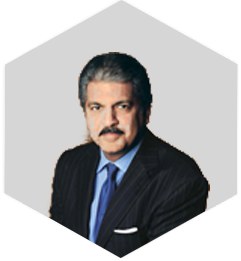Anand Mahindra on Leadership Practices

Anand Mahindra
Mahindra Group is in Aon Hewitt's Top Companies for Leaders Global List
Q. Congratulations on being recognized as a Top Company for Leaders, both in India and globally. What does this achievement mean to you personally?
A. Thank you for this recognition. I have always seen my role as a sort of a gardener whose job is to prepare the soil by creating a culture where people can blossom and grow. So for me personally, this accolade perhaps signifies that we are succeeding in mgrowing that ideal garden. A lot of the credit goes to the strong talent management process developed by our HR.
Q. When was your personal 'penny drop' moment, at which you decided to begin the journey towards being a Top Company for Leaders?
A. The first penny drop moment was a no brainer. To survive in the liberalized economy of the 90's, it was obvious that we had to change, and we had to have the right people leading that change. But a second penny drop moment came when we articulated our first Core Purpose (which has now been replaced by Rise) that Indians are second to none and saw how it galvanized people to take on seemingly impossible odds. That was when it became obvious that we were sitting on top of a mountain of talent, and leveraging that talent would be the booster rocket to success.
Q. When did you decide to introduce external professionals into your leadership team, and what advice would you have for other familyowned enterprises?
A. It depends on what you mean by "introduce external professionals". When the company started in 1945, the only family members were JC and KC Mahindra. All the others were "external professionals". This tradition has continued over the years. If at all family members were involved, it was because they were professionally qualified and competent in their own right. However, over the years, particularly during the socialist years, most people tended to stay with Mahindra from womb to tomb. As a result, the employee population became a bit static, which was understandable in a stagnant business environment. With liberalization, the introduction of fresh blood became an imperative, and this is a process that has been continuing ever since. But even these additions were all external professionals. I am the only family member in an executive role in Mahindra today.
Q. What were the sensitivities and dynamics that you had to face internally?
A. No change effort is ever easy. There is always reluctance to move away from the way things were being done. Also, it is not always easy for a new person to fit into the culture. Some new hires succeeded, some did not. But ultimately, it was the marketplace that compelled the organization successfully to achieve a major transformation of mind sets, business models, and a new paradigm of working as a federation of empowered businesses.
Q. How did this impact power structures, governance and decision-making?
A. A lot of the change was brought about by restructuring the way our business was organized. This automatically created new roles and did away with the older power structures. Decision-making become more decentralized and more empowered but also more accountable. When we restructured into six business sectors, each having both authority and responsibility for their bottom line, management perspectives naturally became more holistic. There were no major issues of governance, because ethics and good governance had long been established as core values by which we lived.
|